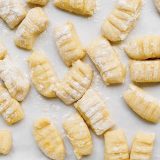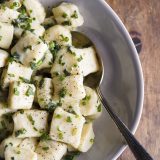Something finally has changed in the City of Lights. After years of French chefs lagging behind the culinary curve—English, American and Japanese chefs were innovating here more than locals—the French have risen to the occasion, says Lindsey Tramuta, author of “The New Paris.”
This can mean refreshed bistro fare at La Bourse et La Vie (steak frites, duck breast with roasted endive, mousse au chocolate and classic crème caramel), the amazing meats, produce and baked goods at La Maison Plisson, or the cooking of Peter Orr at Robert, located in the 11th arrondissement, far from the cafés of the 6th.
Robert is located on residential Rue de la Fontaine, near the canal, a popular place for picnicking on a summer’s night, bar hopping, or even impromptu dancing. Orr has cooked Thai food in London and Italian food in Dubai. Now in Paris he’s venturing into new territory, bringing along his pasta and ramping up the desserts with his girlfriend, pastry chef Quina Lon.
Stepping into the restaurant on a crowded Saturday night, one notices an open kitchen, a small modern dining room and a startling menu. We started with an unlikely combination of lobster, walnuts, peaches and tomato. Odd couples to be sure, but the result was spectacular. Light, cloudlike gnocchi topped with artichokes and fresh chèvre followed. Then cod with courgettes (zucchini), green peas and crab was perfection. Dessert was matcha ice cream with poached pears.
This was a living-on-the-edge menu that could easily have ended up as a gustatory train wreck, an uninformed mashup of ingredients
It was the gnocchi, the most classic of the courses, that impressed when we went back to Robert for a private cooking lesson. It is a dish that I could make at home, so I was keen to see Orr in action.
He boiled a half-dozen large potatoes in salted water, then popped them into the oven to finish cooking, drying them out. The still-hot potatoes then were peeled and riced into a large bowl. The ricing makes for lighter gnocchi than mashing.
For the perfect dough, the potatoes were weighed on a digital scale, then flour was added to achieve the ideal ratio. Just one egg was added, and the dough was mixed and rolled into long logs, cut into pieces and pressed with a small wooden gnocchi paddle. To cook, they were simmered for an extra minute or so after they floated to the surface. A simple sauce of browned butter and sautéed chanterelles provided the perfect accompaniment.
Back at Milk Street, we peeled the potatoes before boiling and skipped potato to 5 ounces flour; less flour makes a stickier dough that's difficult to shape and gnocchi that don't hold together when cooked.
Orr was right—one egg was perfect, but we added ½ teaspoon baking powder to lighten the final cooked gnocchi. A cheat, perhaps, but it worked. We shaped the gnocchi with a fork since few home cooks have the appropriate paddle. Finally, one can freeze the gnocchi after boiling them, but they need to be thawed for an hour before using. Preparing them while still frozen produced unevenly cooked, often gummy gnocchi.
The resulting recipe was simple, and the finished gnocchi were cloud-like. It’s the one homemade pasta that anyone can add to their repertoire.





